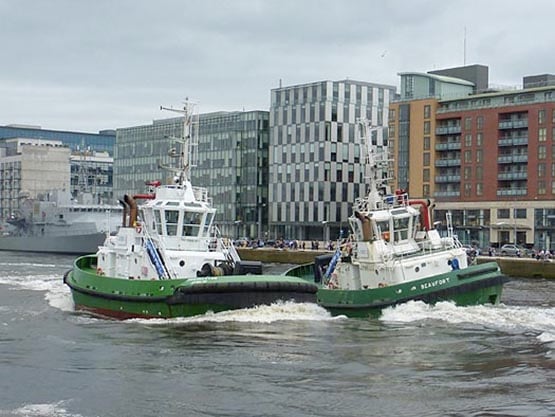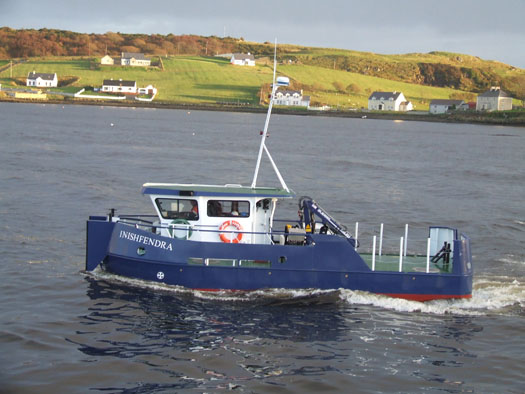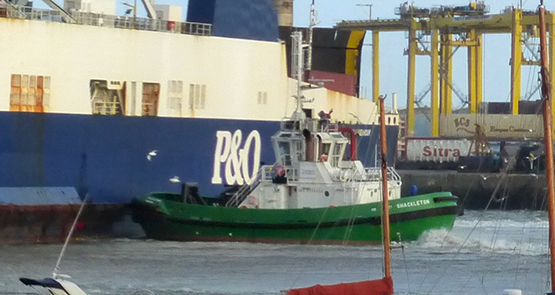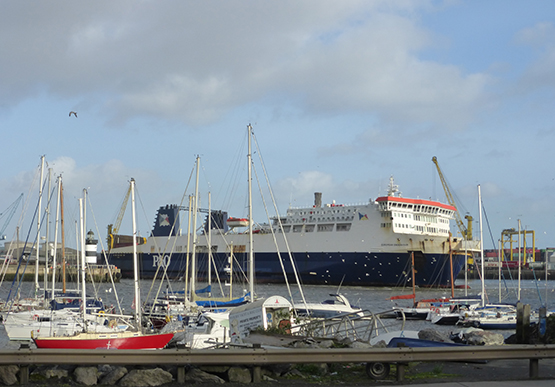Displaying items by tag: Tug
Push Comes To Shove For Dublin Port Tug Shackleton
Any ship coming into Dublin Port in today’s gales after crossing the Irish Sea will have felt mighty glad to get into the shelter of the port. But for P & O’s European Endeavour late this morning, there was the additional tricky matter of getting turned in the river without taking out the Poolbeg Y & BC marina, and then going astern into her berth in the Alexandra Basin writes W M Nixon.
Fortunately the renowned Dublin Port push-me-pull-you tug Shackleton (one of the pair with her sister-ship Beaufort) was on hand to show what she can do when a real heave in any direction is needed, and though it took time, the Endeavour was lined up and slid neatly into place.
Shackleton sets to her work. The wind freshened markedly as the manoeuvre was under way. Photo: W M Nixon
Many Afloat.ie visitors will be familiar with the “Ballet of the Tugs” performed by Shackleton and Beaufort during the Dublin Riverfests. But as this morning’s task showed, while the tugs may well be game to perform as an all-singing all-dancing act, when there’s work to be done they’re more than able for it, as this sequence shows. The photos as usual fail to capture a sense of the real strength of the breeze – Dublin Airport was recording 40 knots with 50 knot gusts, and it got fresher after that, a real winter gale. But when summer comes, doubtless we’ll see the ballet again, and we sign off with a pic of that.

Summertime in Dublin. The hard-working Shackleton takes time out for a spot of Strictly with her sister-ship Beaufort. Photo: W M Nixon
New Tug for Shannon-Erne Waterway
#INLAND WATERWAYS - Waterways Ireland has taken delivery of its third tug boat from Mooney Boats of Killybegs.
Designed by Marine Design International, the Inish Fendra is an 11.2-metre LOA steel-built tug which has been specifically tailored for operation on the Shannon-Erne waterway system.
Its design bears many similarities to the Inis Muillin, which was delivered by Mooney Boats in 2010.

The new tug, Inisfendra built by Mooney Boats of Donegal
According to Maritime Journal, the design process "involved significant input from the vessel operators and managers combined with the latest technology and ideas from the designers and builders to improve on efficiency" and safety.
A key feature of the Inish Fendra is its 3,500-litre ballast tank and pumping system, which is operated by the push of a button and can reduce the vessel's air draft by 0.2m.
Maritime Journal has much more on the Inish Fendra HERE.
Dunmore East Bids TallShips Farewell
As the Russian 'A' class Mir passed the LE Aoife off Dunmore East in mid-morning, the largest tall ship of the festival headed the start of the Parade of Sail, writes Jehan Ashmore.
Crowds left their cars in fields outside Dunmore East and descended into the harbour and surrounding headlands to witness the highlight of the four-day festival. Adding to the scene were the numerous leisure-craft, yachts and intrepid kayakers that gathered to greet the procession which took some two hours to pass the fishing harbour.
No sooner had the fully-rigged ship Mir had slipped beyond the anchored naval vessel that the gaff schooner Johanna Lucretia, under full sail came closer into view. She was closely followed by the Ocean Youth Trust Scotland's Bermudan cutter Alba Explorer.

The Russian 'A' class Mir passing the LE Aoife off Dunmore East. Photo: Jehan Ashmore
Of all the 45 tallships participating the Columbian Navy's barque ARC Gloria presented the most colourful entrant. She proudly flew a large horizontal tricolor of yellow, blue and red representing the South American nation.
When it came to the turn of the Europa to pass the LE Aoife, the tug Bargarth gave a wonderful send-off with the traditional display of water jets shooting sky-high, nearly reaching the top of the three-masted barque.
Marking the tail-end of the parade was the Jubilee Sailing Trust's Lord Nelson, another barque that departed the estuary with the Hook Head Lighthouse forming a majestic backdrop.
At this stage several of the large tallships could be seen on the far horizon in preperation to the start of the first race leg of this years Tall Ships Races....next port of call Greenock!
- Waterford
- ship
- Dunmore East
- Lord Nelson
- Waterford Estuary
- LE Aoife
- Sail Training International
- Jubilee Sailing Trust
- Tug
- Hook Head
- Tall
- JOHANNA LUCRETIA
- TallShips
- Waterford Harbour
- JST
- Europa
- Fullyrigged ship
- STI
- ARC Gloria
- Hook Head Lighthouse
- Mir
- Gaff schooner
- Ocean Youth Trust Scotland
- Bermudan cutter
- Alba Explorer
- Columbian Navy barque
- Bargarth
- Fastnet Shipping
Shackleton Spearhead's Into Dublin Bay
Lord Mayor of Dublin and Admiral of Dublin Port, Gerry Breen, performed the 523 year-old "Casting of the Spear" ceremony in Dublin Bay on midsummer's day, writes Jehan Ashmore.
The 'casting' for yesterdays' re-enactment by the Lord Mayor took place onboard the Dublin port Company tug Shackleton.
From the deck of the Spanish built 50-tonne bollard pull tractor-tug, a spear was launched into the sky and fell deep into the cold water's of Dublin Bay. The ceremony once again marked the position of the city boundaries eastwards.
The medieval tradition of 'Casting of the Spear' dates back to 1488 when the then Lord Mayor, Thomas Mayler, set out on his horse to ride the city's boundaries.
According to historical records he rode out onto the strand as far as a man might ride and from there he cast a spear into the sea. At that time, casting the spear demonstrated the extent of the city boundaries eastwards.
The tradition marks one of many significant moments in Dublin Port's long history since its establishment as a trading post some 1,200 years ago.
Irish cargo-ship remains aground off Drogheda Port
The Drogheda Port Company's patrol launch, Boyne Protector has been monitoring the situation as the Arklow Raider lies close to the entrance of the Co. Louth port.































































